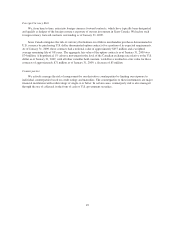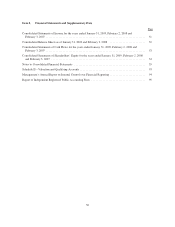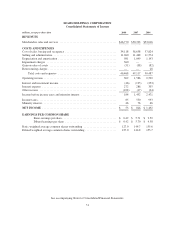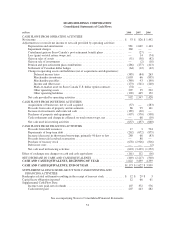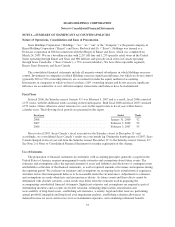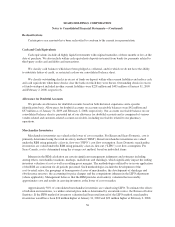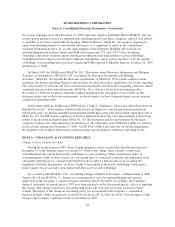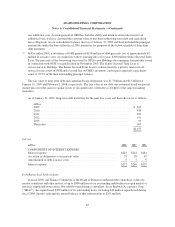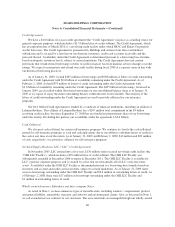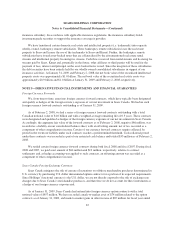Sears 2008 Annual Report Download - page 59
Download and view the complete annual report
Please find page 59 of the 2008 Sears annual report below. You can navigate through the pages in the report by either clicking on the pages listed below, or by using the keyword search tool below to find specific information within the annual report.SEARS HOLDINGS CORPORATION
Notes to Consolidated Financial Statements—(Continued)
inception and at least quarterly thereafter, whether the derivatives that are used in hedging transactions are highly
effective in offsetting changes in either the fair value or cash flows of the hedged item. If it is determined that a
derivative ceases to be a highly effective hedge, we discontinue hedge accounting.
For interest rate swaps and caps that have been designated and qualify as hedges, both the effective and
ineffective portions of the changes in the fair value of the derivative, along with the offsetting gain or loss on the
designated hedged item that is attributable to the hedged risk, are recognized in the consolidated statements of
income in the same account as the hedged item, as a component of interest expense. Changes in the fair value of
interest rate swaps and caps that do not qualify as hedges are recognized currently as a component of interest
expense. The foreign currency forward contracts are recorded on the consolidated balance sheet at fair value and,
to the extent they have been designated and qualify for hedge accounting treatment, an offsetting amount is
recorded as a component of other comprehensive income, net of income tax effects. Changes in the fair value of
those forward contracts for which hedge accounting is not applied are recorded in the consolidated statement of
income as a component of other income. Certain of our currency forward contracts require collateral to be posted
in the event our liability under such contracts reaches a predetermined threshold. Cash collateral posted under
these contracts is recorded as part of our restricted cash balance.
We have, from time to time, invested our surplus cash in various securities and financial instruments,
including total return swaps, which are derivative instruments designed to synthetically replicate the economic
return characteristics of one or more underlying marketable equity securities. Such investments may be highly
concentrated and involve substantial risks. Changes in the fair value of the total return swaps are recognized as a
component of interest and investment income in our consolidated statements of income as they occur. We had no
investments in total return swaps as of January 31, 2009 or February 2, 2008.
Fair Value of Financial Instruments
We adopted SFAS No. 157, “Fair Value Measurements” on February 3, 2008. SFAS No. 157 defines fair
value, establishes a framework for measuring fair value in GAAP and expands disclosure requirements about fair
value measurements. Under SFAS No. 157, fair value is considered to be the exchange price in an orderly
transaction between market participants to sell an asset or transfer a liability at the measurement date. The fair
value definition under SFAS No. 157 focuses on an exit price, which is the price that would be received by
Holdings to sell an asset or paid to transfer a liability versus an entry price, which would be the price paid to
acquire an asset or received to assume a liability. Although SFAS No. 157 does not require additional fair value
measurements, it applies to other accounting pronouncements that require or permit fair value measurements.
Financial instruments that potentially subject Holdings to concentration of credit risk consist principally of
temporary cash investments, accounts receivable and derivative financial instruments. We place our cash and
cash equivalents in investment-grade, short-term instruments with high quality financial institutions and, by
policy, limit the amount of credit exposure in any one financial instrument. We use high credit quality
counterparties to transact our derivative transactions.
We determine the fair value of financial assets and liabilities based on the fair value hierarchy prescribed by
SFAS No. 157, which prioritizes the inputs to valuation techniques used to measure fair value into three levels.
See Note 5 to the consolidated financial statements for further information regarding our derivative positions.
Cash and cash equivalents, accounts receivable, merchandise payables, credit facility borrowings and
accrued liabilities are reflected in the consolidated balance sheet at cost, which approximates fair value due to the
short-term nature of these instruments. The fair value of our debt is disclosed in Note 4 to the consolidated
financial statements.
59


